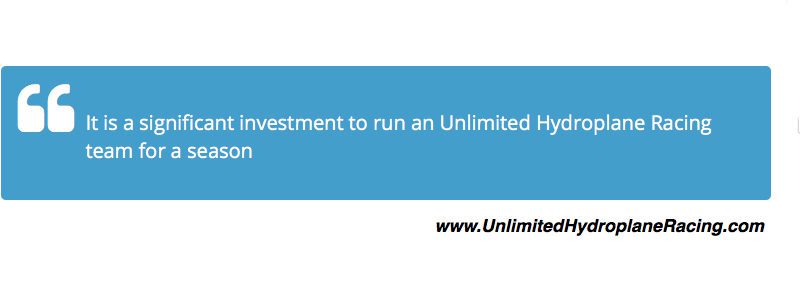Seeking Sustainable Financial Model
Year end is always a convenient time to reflect on the past year(s) and look toward the new one. Our sport of Unlimited Hydroplane Racing is no different.
At about this time last year, I offered my 2-part perspective for 2017. In Part 1, “New Year’s Resolution for H1” I strongly encouraged H1 Unlimited to explore all options for rejuvenating our sport when they conducted their 2017 Annual Meeting.
In Part 2, “Possible H1 Meeting Topics” I offered five potential areas of focus for the Annual Meeting. One of them, “Revenue Sharing – Will Race Teams Get More Money?” is actually front and center today.
It’s a little disheartening to think that the other topics are not even on the radar.
As far back as 2015, in “Hydroplane Racing: Sport or Hobby?” I offered perspectives about whether the sport of Unlimited Hydroplane Racing was moving toward “sport” or “hobby” mode. Today, I’ll focus on the sport side of that equation, specifically being run as a business.
Business Balance

There are three forces in our sport that have unique and in most cases, competing needs:
- Event Organizers
- Racing Teams
- H1 Unlimited
It costs money to put on a watersports event that features Unlimited Hydroplanes. It costs money to run an Unlimited Hydroplane Racing team. It costs money to organize the teams to manage and sanction the events at which they race.
To be a sustainable operation, the sport of Unlimited Hydroplane Racing needs a sustainable business model. Consistent, long term goals and consistent operating tenets that will benefit all parties. Without that consistency, planning suffers and by association, financial performance.
Let’s take a look at the unique needs and challenges for each of these forces.
First: The Event
The impresarios who spearhead events like Bayfair, SeaFair, or any of the water-based “Fairs,” must strike a careful balance. They must create a compelling event that people want to attend. Attendance enables the charging of admission. They must earn enough to pay for all the activities, put a few bucks in the bank, and then do it again the following year.
The bank is the key element. No one should begrudge an event for making some profit. Profit (and the bank savings that should result from that profit) helps to keep things afloat when the balance sheet gets tight in future years. That buffer helps things continue, fostering the consistency mentioned above.
No one should begrudge an event for making some profit
Only the event organizers know their real costs. But I’d be the first to submit that it is expensive to put on a good show, so it is important to watch every dollar spent.
Second: The Race Teams
Current race team owners can be classified in two distinct ways – those who are content to race as a hobby, and those who want to run their teams as a business.
Those who want the business model approach would either expect to at least break even on their activities, or show a small profit like the event organizers above, to put away for a rainy day.
For the hobbyists, the only financial limit is their pain point: at what point does paying for the hobby begin to “hurt?” For this analysis, I’ll be looking just a the business case.
As we look to 2018, it would make sense to review the basics about what it takes “to race” and identify key topics to keep in mind as we move ahead.
Race teams are no different than race sites in their need for a sustainable business model: earn enough in sponsorship and tow money fees each year to pay for the costs to provide the boat and team.
Unlike the event budgets, as Damn Smart Fans of Unlimited Hydroplane Racing, we can guesstimate season costs. One point needs to be clear: these are estimates only for the sake of this analysis. Each team’s picture is different and individual budgets can vary substantially.
A propeller that lasts for 200 minutes can cost upwards of $15,000. Unless a team is willing to take a significant gamble on over-time props, two will be needed for a season.
That’s $30,000 for just one component of the boat! Factor other parts and materials used just to run the boat, new and replacement equipment to maintain the boat, repairs when the inevitable damage occurs to the boat, travel costs, etc. and it’s easy to project that it could cost upwards of $300,000 to run a full season.
And remember, much of the crew time is volunteer!
Yes, I know it could be less and it could be more. The point is that it is a significant investment to run an Unlimited Hydroplane Racing team for a season.
It is a significant investment to run an Unlimited Hydroplane Racing team for a season
The more significant the costs, the more important it is for consistent revenue expectations, allowing a longer and more effective planning horizon.
Third: The Sanctioning Body
While this post is not meant to be an H1 Unlimited bashing, consistency has not been their strong point in recent years. Exhibit A causing significant challenges: A revolving door of Chairmen.
When looking at finances, it’s natural to start with “Revenue” and then look to “Expenses,” but to make a point, I’ll start with expenses. (General administrative overhead is not being addressed here; only from team and race perspectives.)
Expenses
Based on the 2017 Unlimited Hydroplane Racing season and H1 Unlimited’s payment structure, a team that ran all five races received about $70,000 in “Tow Money.” Those who went to fewer races received far less.
Based on our Teams analysis above, that would leave about $230,000 for the teams to earn in sponsorships just to “break even” for a full race season. That’s about $46,000 PER RACE!
Look at the sponsor list that changes from race to race, and it’s obvious how difficult it is for teams to cover their costs. Many do, so this is not meant to suggest we feel sorry for the teams – it is meant to show the need for consistency year-to-year and race-to-race.
The point here is that while H1 Unlimited has significant expenses to remunerate teams for their participation, it is a small amount of the overall cost to field a team.
There is a need for deep, long term, trusting relationships between teams and their sponsors. The reason? There are competing and compelling ways those same sponsors can advance their brand visibility. For example, a potential local or regional sponsor could conceivably run 750 to 1,000 thirty-second TV commercials on their regional cable carrier for about the same $46,000.
In my opinion, running TV commercials does not create the same emotional connection to a brand as an Unlimited Hydroplane dancing across the water on a summer day, but options do exist.
Every entity has their own planning horizon. Consistency is critical to help a team plan and develop deeper and longer-term relationships with advertisers.
Now let’s look at Revenue
H1 Unlimited’s years-long practice of accepting varying amounts from race sites has come back to bite them this year. As a legacy race site, the Madison organizing committee has already indicated they are refusing to pay more than the otherwise lowest paying site.
Simple math: Less money paid to H1 = less Tow Money for teams = more need for sponsorship support. This is not insurmountable, but is exponentially more difficult if it happens just before the upcoming season.
Applying an inconsistent financial model such as this can lead to a stand-off with team owners who are doing their best to run their teams as a business. Ultimately, that stand-off could mean the end of some races, since the race sites have minimum boat counts in their contracts.
If this causes more sites to be eliminated from the schedule, it may just be the beginning of the end for Unlimited Hydroplane Racing.
It isn’t out of the question that Madison could have only a Grand Prix World event this coming season. That’s really not the way Damn Smart Fans would like to start a Happy New Year!
What do you think? How would you build a working financial model to position Unlimited Hydroplane Racing for a sustainable future?
UHR Dave



Well thought out and written. Would like to get the owners all together and discuss and hammer out a plan. This sport I love is hanging on by a thread.
One of the points that you hit on , ie: sponsors marketing dollars, more to the point… marketing. For the years of my involvement with boat racing, the one thing that stands out across the board is the lack of or failure to address a marketing strategy that would benefit the sport and the venues that host them.
There was one instance where radio advertising in the region was implemented and the public response for the event was outstanding.
Right now, most of the people involved with the sport don’t concern themselves with marketing at their level because they figure that this will be handled by the venue ( hosting club ). The unfortunate truth is that their perception of appropriate marketing is minimal at best.
More specifically, they put posters in the windows of shop sponsors in the town the event is being held and call it good.
Likewise, from the H1 level, the venues advertising is limited to the local area of the event which leaves many of the local residents of the town in the dark because of the minimalist marketing method that is used.
Corrective action in this area is a must if there is any hope for this sport to survive. Local APBA clubs need to add to their budget marketing funds and actively/aggressively raise the sponsor dollars needed to make it happen. On the H1 venue side of things, H1 needs to take the bull by the horns and address the race sites current marketing method and develop a collective marketing program that is supported and funded by all the race sites making better use of the advertising dollar.
Basically, H1 and their race sites should be looking at one commercial that broadcasts all the events every time it plays. For each site to spend money on advertising for “their event only” is collectively dropping the ball for the sport and hurting the return on investment for their event.
Finally, as you have pointed out, there are those that seem to be hobbyists and then there are those that want it to be a business. Either way, without a proper marketing program there won’t be a venue for either group to attend.